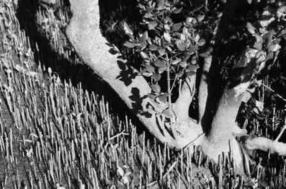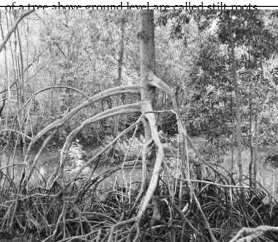4.7.1. Characteristics of mangroves
♤ They are basically evergreen land plants growing on sheltered shores, typically on tidal flats, deltas, estuaries, bays, creeks and the barrier islands.
♤ The best locations are where abundant silt is brought down by rivers or on the backshore of accreting sandy beaches.
♤ Their physiological adaptation to salinity stress and to water logged anaerobic mud is high.
♤ They require high solar radiation and have the ability to absorb fresh water from saline/brackish water.
♤ It produces pneumatophores (blind roots) to overcome respiration problem in the anaerobic soil conditions.

Pneumatophores
♤ Mangroves occur in variety of configurations. Some species (e.g. Rhizophora) send arching prop roots down into the water. While other (e.g. Avicennia) send vertical “Pneumatophores” or air roots up from the mud.
♤ Most mangrove vegetation has lenticellated bank which facilitates more water loss, produces coppices. Leaves are thick and contain salt secreting glands.
♤ Mangroves exhibit Viviparity mode of reproduction. i.e. seeds germinate in the tree itself (before falling to the ground). This is an adaptative mechanism to overcome the problem of germination in saline water.
♤ Some secrete excess salt through their leaves as if you look closely, you can see crystals of salt on the back of the leaves; others block absorption of salt at their roots.
♤ Adventitious roots which emerged from the main trunk

ifofiv irl Irt'i
Stilt Roots

Do you know?
The word amphibian means two-lives. Amphibians spend their lives in the water and on land. All amphibians begin their life in water with gills and tails. As they grow, they develop lungs and legs for their life on land. Members of this animal class are frogs, toads, salamanders, newts, and caecilians or blindworms. Amphibians shed their skin as they grow. Usually the shed skin is eaten.
